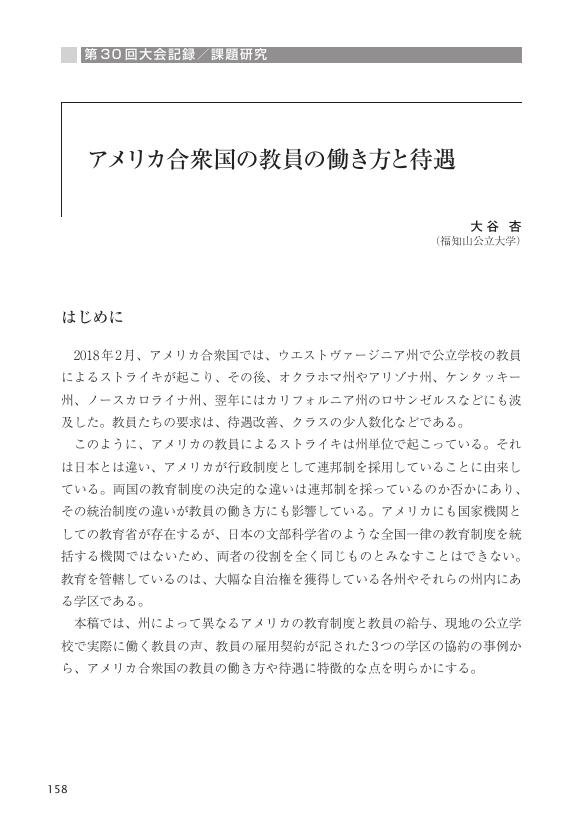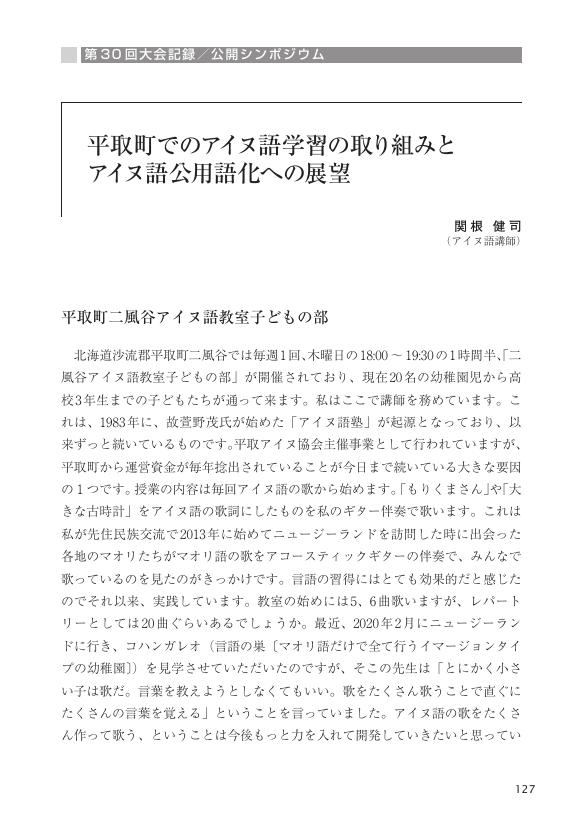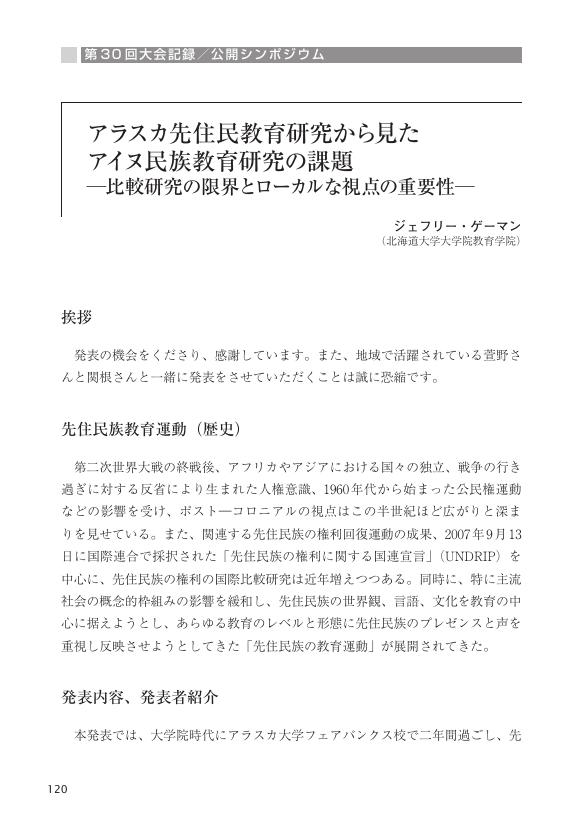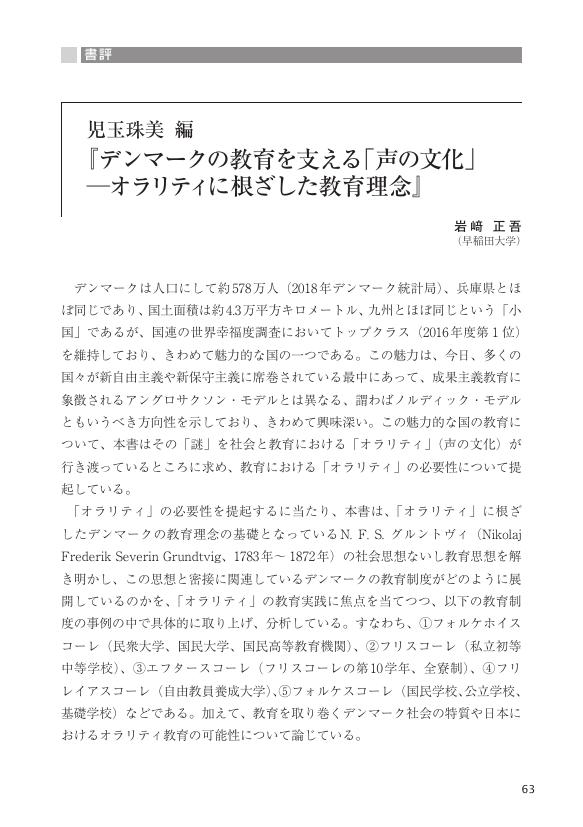30 0 0 0 OA 言語罰札制度について 沖縄の「方言札」を中心に
- 著者
- 井谷 泰彦
- 出版者
- 日本国際教育学会
- 雑誌
- 国際教育 (ISSN:09185364)
- 巻号頁・発行日
- vol.18, pp.54-63, 2012 (Released:2020-07-31)
This paper aims to deepen historical understanding of the Okinawan identity through a study of the dialect punishment board (hogen fuda). Up until 1879, in Okinawa, ordinary people used the Ryukyuan language. In the Ryukyu Islands, people in different groups had different dialects. The difference between their dialects was very wide compared with dialects in mainland Japan. In the Meiji period, the Japanese national government started teaching standard Japanese all over Japan including Okinawa in order to establish a unified language in their attempt to modernize the nation. It was linked with other policies of the government such as developing national wealth, strengthening the military and educating the masses as subjects of the Emperor. Meanwhile, Okinawan people, afraid of discrimination, wanted their own unified language. Because discrimination was often caused by differences of dialect, they wanted to communicate to other people without a language barrier. In schools and some village communities in Okinawa, the dialect punishment board (hogen fuda) was made for every classroom and some community centers. Students had to wear it around their necks if they spoke in dialect. The tag was handed over to other students who spoke in their dialect. The method was common under the Customary Law of Okinawan Villages. Though this method of language enforcement led to the repression of Okinawan culture and language, it was never official government policy. Certainly, standard Japanese was forced on Okinawan people in prewar times by the prefectural government. However, popular opinion supported enforcement of the use of standard Japanese as a way to adapt to the new era. The dialect punishment board continued to be used in Okinawa even after the war until around the 1970s. They chose the standard Japanese of their own will during the postwar period. After reversion in 1972, the use of standard Japanese rapidly spread among ordinary people due to wide exposure to television, freedom to travel to and from mainland Japan and the development of tourism. As a result, the young generation born after reversion can rarely speak dialects.
21 0 0 0 OA 香港の「通識教育科」の形成過程と雨傘運動
- 著者
- 中井 智香子
- 出版者
- 日本国際教育学会
- 雑誌
- 国際教育 (ISSN:09185364)
- 巻号頁・発行日
- vol.22, pp.105-120, 2016 (Released:2019-01-31)
- 参考文献数
- 25
This study focuses on the intention of incorporated “Liberal Studies” as a compulsory subject for all senior secondary students, its present-day impact on the social awareness of youngsters, and its influence on the Umbrella Movement of 2014. The study analyzes not only syllabi but also public examination questions including comments and scoring criteria in terms of the severely examination-orientated educational system in Hong Kong. Liberal Studies consists of six modules as a cross-curriculum. Initially, in 1992, it was introduced for senior secondary third-grade students; in 2009, it was promoted from an elective to a compulsory subject. Eventually, it took over Citizenship Education shaping Civil Society across the handover. Finally, the premature intention matched the aim of shaping the knowledge-based economy underpinned by the education and curriculum reforms under the new Hong Kong government. According to its developers, Hong Kong’s curriculum of Liberal Studies based on Independent Inquiry Study was designed to establish student-centered learning in the educational system, as well as to develop high-level learning skills, such as critical thinking, independent thinking and problem-solving. In other words, it aimed at fostering new generations who are different from the apolitical generations and have social awareness regarding civil society by utilizing live news media materials instead of textbooks. Both the Liberal Studies modules of Hong Kong Today and Modern China are deliberately designed to shape social awareness motivated critical thinking in students. The first syllabus for the elective subject was issued in 1991; it was revised in 1996 and 2000, and subsequently in 2007 as a compulsory subject. Regarding the development of critical thinking, the previous three editions claimed to solely generate “critical awareness”; however, the 2007 edition embodied “positive values”, “proactive attitudes”, and “social awareness” concepts. The 2000 edition was relatively simple; in this edition, the concept of “democracy” was wholly absent and the concepts of “rule of law” and “freedom” were only partly discussed. Meanwhile, the 1996 edition was added to “press freedom” and compared to the Chinese official media, defined as the mouthpiece of the government and the Communist Party. The 1991 and 1996 editions emphasized the critical difference between Hong Kong and China, “Socialism vs. Capitalism” and “China-model democracy vs. Western-model democracy”. The examination questions have consistently sparked fresh controversies, and the scoring criteria also have triggered an in-depth discussion on their exact framework as well as a statement on the highly critical analysis. However, regarding the perspectives toward China expressed by the questions, the dichotomy between the two has been altered to multiple perspectives so that students can understand China’s stance following the issuance of the 2000 edition. In conclusion, the incorporation of Liberal Studies has strongly stimulated students’social awareness, and its impact expanded to all students after the subject became compulsory in 2009. Accordingly, this study indicates that university and senior secondary students, comprising the compulsory Liberal Studies generation, somehow embody critical thinking so that they frequently take an anti-government stance, including the creation of the Umbrella Movement.
7 0 0 0 OA 内モンゴル自治区におけるモンゴル民族の幼稚園選択要因
- 著者
- 烏日吉木斯
- 出版者
- 日本国際教育学会
- 雑誌
- 国際教育 (ISSN:09185364)
- 巻号頁・発行日
- vol.22, pp.121-138, 2016 (Released:2019-01-31)
- 参考文献数
- 19
In China, the equal use and development of minority languages are guaranteed by law. However, the rate of use of Chinese in the place of Mongolian has risen in the Inner Mongolian Autonomous Region, and the loss of Mongolian and a trend towards the use of Chinese as a mother language are particularly marked in the case of Mongolians living in urban areas. Maintenance of the Mongolian language by Mongolians and its transmission to the younger generation have become an issue. Whereas the learning of Chinese and English is being stressed from childhood, use of the ethnic language has become narrower, and ethnic language ability has also declined. It is necessary to search for the factors in the selection of a kindergarten for young Mongolian children in the Inner Mongolian Autonomous Region. The choice of a kindergarten is the first school choice, and since it has a major effect on the selection of schools thereafter, the choice of a kindergarten is extremely important. To answer the question in regard to key factors in the initial selection of a kindergarten, this chapter focuses on kindergarten selection in the Inner Mongolian Autonomous Region, and takes as its purpose the examination of these determinant factors. The study primarily uses domestic data related to kindergarten education, interview/survey data, and a comparison of two different types of kindergartens that each follow a different medium of instruction and terminology. Additionally, the statistical data is used to evaluate the current state of kindergarten education in Inner Mongolia, and identify its influence on kindergarten selection. Furthermore, the survey data, followed by a cross tabulation analysis, reveals the determinant factors of why a particular kindergarten was selected. This survey was conducted from August 30, 2013 to September 30, 2013. The subjects of the survey were the parents of ethnic Mongolian children aged between four and five years old in the city of Huhhot in the Inner Mongolia Autonomous Region of China. Huhhot is the capital of the Inner Mongolia Autonomous Region and the area most densely populated with Han and Mongolian peoples. Three ethnic Mongolian and three ethnic Han kindergartens were chosen as samples for the survey. The researcher surveyed 208 parents, minding the balance between the number of infants in both types of kindergartens. Three themes surfaced as a result of the above research and analysis. First is the linguistic factor, where Mongolian people who select an “ethnic Mongolian” kindergarten attribute their choice to the ability of their children to learn their mother tongue, and where Mongolian people who select a Han kindergarten attribute their choice to the ability of their children to learn both English and Chinese. Second, there are fewer “ethnic Mongolian” kindergartens in Inner Mongolia, which is an important factor for this group’s kindergarten selection. Finally, family background plays a vital role in the selection of a kindergarten, with circumstances such as the father’s low education level, the high income of a household, and one of the parents not belonging to the ethnic Mongolian group emerging as determinant factors. For example, if the language used in the home is primarily Han, the possibility that parents will select a Han Chinese kindergarten is high.
4 0 0 0 OA 国際教育政策の借用メカニズムに関する一考察 ─カナダ国際教育戦略を事例に─
- 著者
- 花田 真吾
- 出版者
- 日本国際教育学会
- 雑誌
- 国際教育 (ISSN:09185364)
- 巻号頁・発行日
- vol.22, pp.10-34, 2016 (Released:2019-01-31)
- 参考文献数
- 23
3 0 0 0 OA アメリカ合衆国の教員の働き方と待遇 課題研究 「国際比較から見る教員の働き方改革」
- 著者
- 大谷 杏
- 出版者
- 日本国際教育学会
- 雑誌
- 国際教育 (ISSN:09185364)
- 巻号頁・発行日
- vol.26, pp.158-166, 2020 (Released:2022-03-14)
- 著者
- 岩﨑 正吾
- 出版者
- 日本国際教育学会
- 雑誌
- 国際教育 (ISSN:09185364)
- 巻号頁・発行日
- no.20, pp.1-16, 2014-09
- 著者
- 岩﨑 正吾
- 出版者
- 日本国際教育学会
- 雑誌
- 国際教育 (ISSN:09185364)
- 巻号頁・発行日
- vol.20, pp.1-16, 2014
- 著者
- 郭 孟倪
- 出版者
- 日本国際教育学会
- 雑誌
- 国際教育 (ISSN:09185364)
- 巻号頁・発行日
- vol.25, pp.118-124, 2019 (Released:2020-09-08)
2 0 0 0 OA 高等教育における国際連携 上海交通大学・ミシガン大学の事例
- 著者
- 黒田 千晴
- 出版者
- 日本国際教育学会
- 雑誌
- 国際教育 (ISSN:09185364)
- 巻号頁・発行日
- vol.25, pp.1-17, 2019 (Released:2020-09-08)
- 参考文献数
- 15
- 被引用文献数
- 1
This paper presents an empirical study of international collaborative education offered at an Institute which was jointly established by two leading universities of China and the US—namely Shanghai Jiaotong University and the University of Michigan. The Institute was formed in Shanghai Jiaotong University in 2006 under the regulatory scheme “Chinese–Foreign Cooperation in Running Schools”; it offers undergraduate, masters, doctoral, and international collaborative programs in the field of engineering. Adopting a case study approach, this work aimed to explore the prospects and challenges generated through international collaboration in higher education. Qualitative data were acquired by document analysis and semi-structured interviews with key informants. The author first examined the motivation of each parent university to pursue the establishment of the Institute, explored the outcomes of the collaboration, and finally discussed the remaining issues. The findings generated from the case analysis were as follows. The US parent university intended to create an educational/research hub for their students and faculty in China to provide opportunities of collaborating with Chinese students and researchers at the Chinese partner university. It also expected to gain access to high-achieving Chinese students for recruitment to graduate programs in the US parent university. Another intention was to enhance its reputation in China through the collaboration with the Chinese parent university, which is a leading higher education institution in China. Meanwhile, the Chinese parent university particularly aimed to gain know-how in academic–industrial partnership, enhance international competitiveness through joint research, and improve the quality of their education by importing advanced educational resources and curriculum through the collaboration. While the data of this case analysis reveal that most of the objectives of both parent universities were achieved satisfactorily, complexity was also observed. As depicted above, one of the objectives was to strengthen the research collaboration between the existent departments, the Institute, and the US parent university. The research collaboration however remains limited; there is an emerging competition between the existent departments and the Institute in terms of student recruitment. This is attributed to the duplication of the programs offered by the existent departments and the Institute. Furthermore, a so-called “brain drain” has emerged as a complex issue. A large portion of the graduates of the Institute have pursued advanced degrees at graduate schools mostly in the US, and most of the graduates have been admitted to graduate programs at the US parent university. For the US side, this initiative can certainly be recognized as a successful outcome. By contrast, for the Chinese side, it presents a complex issue in terms of retention of highly skilled human resources. Another remaining challenge is the inequality of access to the programs offered at the Institute. Although the Institute is considered an academic department of the Chinese parent university, its tuition fee is much higher than those of the existent departments. Consequently, access to the programs at the Institute is limited to students from affluent families.
- 著者
- 佐藤千津
- 出版者
- 日本国際教育学会
- 雑誌
- 国際教育 (ISSN:09185364)
- 巻号頁・発行日
- vol.20, pp.17-30, 2014 (Released:2019-07-31)
2 0 0 0 OA ノルウェーの高等教育機関と先住民族教育 ─サーミ大学を事例として─
- 著者
- 田辺 陽子
- 出版者
- 日本国際教育学会
- 雑誌
- 国際教育 (ISSN:09185364)
- 巻号頁・発行日
- vol.23, pp.49-64, 2017 (Released:2018-12-31)
- 参考文献数
- 22
Sámi are an indigenous people who originally inhabited Sápmi, the traditional Sámi land that cross-borders Norway, Sweden, Finland, and Russia. Today, it is estimated that approximately 40,000–60,000 Sámi live in Norway (roughly 1% of the total Norwegian population); 20,000 live in Sweden; 7,500 in Finland; and 2,000 in Russia (Sollbakk & Varsi, 2014). During the post-war period, Norway’s welfare state steadily expanded, and the 1950s and 60s witnessed economic prosperity and national development. However, as a tradeoff for modernisation, “Sáminess” was considered unfavourable, and the Sámi people were forced to assimilate into Norwegian society. Against the backdrop of this Norwegianization policy, Sámi peoples—particularly the young, educated Sámi—started to engage in political activities. Among these activities, the damming of the Alta-Kautokeino River in the 1970s was a turning point in the Sámi rights movement. It is noteworthy that the Sámi restored their inherent rights by the end of 1980s and have since been enjoying a relatively high level of self-determination in areas such as education, culture, language and traditional livelihood. In 1988 the Norwegian government amended its constitution, and in October of 1989 it opened the Sámi Parliament of Norway. The year 1989 also marked the establishment of Sámi University College (or Sámi allaskuvla in Sámi) in Kautokeino. It is Europe’s first and only indigenous higher-education institution. The SUC has three departments: linguistics, social science, and Duodji and teacher education. It offers programmes at the bachelor, masters, and doctoral levels, and their unique programmes attract not only Sámi students from Sápmi, but also non-Sámi people from all around the world. However, the total pool of applicants is small, and the university struggles to tackle particular challenges that are unique to them as an indigenous institution. The purpose of this research paper is twofold: (1) to review current Sámi research and education in Norway’s higher-education sector, and (2) to report characteristics and challenges of the educational programmes provided at Sámi University College (SUC) as a case study. In the first section, this reseach examines indigenous education programmes and higher education in Norway by referring to Norwegian government reports, statistics, and newspaper articles. The next section focuses on current issues at SUC, including programmes, student statistics, and other challenges. This research paper should be considered a work-in-progress report. However, considering the limited number of articles on Norway’s higher educaiton available in Japan, it will offer new insights on the progressive, rights-oriented approach of Sámi education. In that sense, the significance of this research lies in the light it sheds on the relatively unknown areas of indigenous education and higher education institutions in Norway.
- 著者
- 呉 世蓮
- 出版者
- 日本国際教育学会
- 雑誌
- 国際教育 (ISSN:09185364)
- 巻号頁・発行日
- vol.24, pp.75-78, 2018 (Released:2019-09-30)
2 0 0 0 OA 日本の学士課程における英語による学位プログラムの発展と可能性
- 著者
- 堀内 喜代美
- 出版者
- 日本国際教育学会
- 雑誌
- 国際教育 (ISSN:09185364)
- 巻号頁・発行日
- vol.22, pp.35-54, 2016 (Released:2019-01-31)
- 参考文献数
- 26
1 0 0 0 OA 平取町でのアイヌ語学習の取り組みとアイヌ語公用語化への展望
- 著者
- 関根 健司
- 出版者
- 日本国際教育学会
- 雑誌
- 国際教育 (ISSN:09185364)
- 巻号頁・発行日
- vol.26, pp.127-132, 2020 (Released:2022-03-14)
- 著者
- ジェフリー ゲーマン
- 出版者
- 日本国際教育学会
- 雑誌
- 国際教育 (ISSN:09185364)
- 巻号頁・発行日
- vol.26, pp.120-126, 2020 (Released:2022-03-14)
- 著者
- 山﨑 直也
- 出版者
- 日本国際教育学会
- 雑誌
- 国際教育 (ISSN:09185364)
- 巻号頁・発行日
- vol.21, pp.140-147, 2015 (Released:2019-04-30)
1 0 0 0 OA インドネシア近代化と元賠償留学生のライフヒストリー
- 著者
- 奥村 惠介
- 出版者
- 日本国際教育学会
- 雑誌
- 国際教育 (ISSN:09185364)
- 巻号頁・発行日
- vol.25, pp.36-49, 2020 (Released:2020-09-08)
- 参考文献数
- 14
The purpose of this study is, firstly, to clarify the admissions system of Indonesian students under the Reparations Agreement signed between Japan and Indonesia in 1958, and secondly, to paint life-histories of these students based upon interviews conducted during a two-month stay in Indonesia in July and September, 2017, and between February and March, 2018 with seventeen informants. These students’ mission was to acquire knowledge of the newest technology as well as to learn the origin of and discover the reasons for the rapid economic development of Japan after the Second World War, for the purpose of founding the new independent state of Indonesia and for the modernization of that country. After 1960, the Japanese government admitted a total of 389 students, eighty percent of whom were science majors and twenty percent humanities majors. These students learned mainly Japanese language for one year, and, after that, were admitted for four more years of study to national and private universities according to their major. This research is based on the cooperation of seventeen ex-student informants who were introduced through PERSADA (An association of Indonesian alumni of Japanese universities) in Jakarta, Indonesia. The survey emphasizes interviews, rather than employing macro or quantitative methods. While staying in Japan, these students learnt not only new technology, but also gained many opportunities to observe Japanese society. Meanwhile, in the Indonesian motherland, political and financial confusion—for example, the 9/30 Incident against the communists which tipped the balance of political power from Sukarno to Suharto, had been occurring throughout the 1960s. As a result, these students sometimes were not all able to successfully or smoothly resume life after returning to their mother country. Findings of this research are as follows; 1) The admissions system of Indonesian students under the Reparations Agreement had been spearheaded mainly by Dr Kusnaeni and Dr H.Enoch Amangku, who had both studied at Japanese universities. 2) Informants emphasized that it is important for Indonesia to develop discipline such as that found in Japanese society for the purpose of founding the independent new state of Indonesia as well as for its modernization. A lack of discipline and ethics causes delays in national development, widespread corruption, decline of the will to work, and so on. Even now Indonesians are suffering from such delays. 3) In addition, after the passing of more seventy years since Independence in 1945, even today it is still the case that Indonesia continues to suffer from conflict between traditional values (Islam, Adat) and modernization. 4) Darma Persada University, established in 1986, was founded by graduates of Japanese universities, mainly former Indonesian students under the Reparations Agreement who have since been pouring their energy into developing ties between Japan and Indonesia.
1 0 0 0 OA 児玉珠美著『デンマークの教育を支える「声の文化」─オラリティに根ざした教育理念』
- 著者
- 岩﨑 正吾
- 出版者
- 日本国際教育学会
- 雑誌
- 国際教育 (ISSN:09185364)
- 巻号頁・発行日
- vol.24, pp.63-67, 2018 (Released:2019-09-30)









